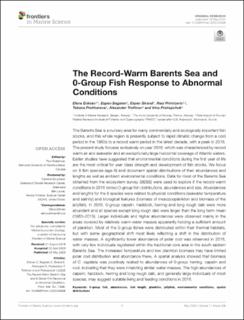| dc.description.abstract | The Barents Sea is a nursery area for many commercially and ecologically important fish stocks, and this whole region is presently subject to rapid climatic change from a cold period in the 1980s to a record warm period in the latest decade, with a peak in 2016. The present study focuses exclusively on year 2016, which was characterized by record warm air and seawater and an exceptionally large horizontal coverage of Atlantic waters. Earlier studies have suggested that environmental conditions during the first year of life are the most critical for year class strength and development of fish stocks. We focus on 8 fish species (age 0) and document spatial distributions of their abundances and lengths as well as ambient environmental conditions. Data for most of the Barents Sea obtained from the ecosystem survey (BESS) were used to explore if the record-warm conditions in 2016 limited 0-group fish distributions, abundances and size. Abundances and lengths for the 8 species were related to physical conditions (seawater temperature and salinity) and biological features (biomass of mesozooplankton and biomass of the jellyfish). In 2016, 0-group capelin, haddock, herring and long rough dab were more abundant and all species except long rough dab were larger than the long term mean (1980–2015). Larger individuals and higher abundances were observed mainly in the areas covered by relatively warm water masses apparently holding a sufficient amount of plankton. Most of the 0-group fishes were distributed within their thermal habitats, but with some geographical shift most likely reflecting a shift in the distribution of water masses. A significantly lower abundance of polar cod was observed in 2016, with very few individuals registered within the traditional core area in the south eastern Barents Sea. The increased temperature and low plankton biomass may have limited polar cod distribution and abundance there. A spatial analysis showed that biomass of C. capillata was positively related to abundances of 0-group herring, capelin and cod, indicating that they were inhabiting similar water masses. The high abundances of capelin, haddock, herring and long rough dab, and generally large individuals of most species, may suggest suitable living and feeding conditions in 2016. | en_US |
